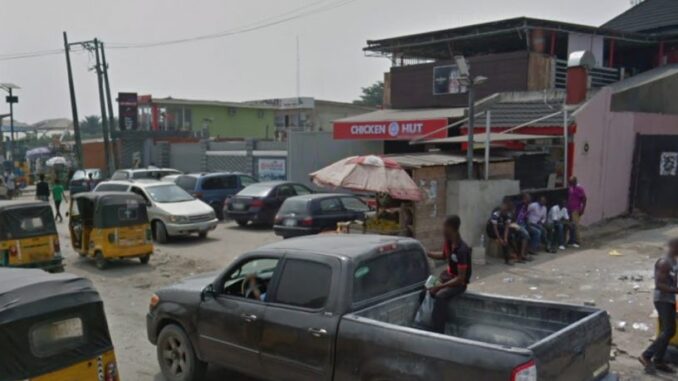
The expressway from Chevron Tollgate to Novare Mall Shoprite and beyond endures chocking vehicular traffic, high carbon emission, and heavy pedestrian movement. Sangotedo, particularly, suffers from cramped road space occasioned by seasonal sand deposits and unauthorized trading along pedestrian walkways.
Ask any motorist what the island’s biggest problem is, and the answer is always the same. Narrow roads, bad spots, and flooding.
The road expansion program of the previous administration got stuck at Abraham Adesanya Roundabout since 2019. Ever since, pedestrians going beyond the roundabout have continued to compete with automobiles for road space as a result of continuously disappearing walkways. To fight for every inch of road space or be held back in endless logjam: that is the challenge facing the Islanders.
This is by no means an exaggeration. Most stock images of Sangotedo depict flourishing real estate and premium virgin lands. The reality is different. The area hosts about 10 standard private schools, about 30 luxury hotels, more than 20 large shopping malls all opening to the expressway, a developed market, as well as estates and neighbourhoods housing about 10,000 adult population. This figure excludes children and minors who are known to constitute about 25 percent of the total population of every city in Nigeria. There is a large army of artisans and school leavers who swell the pedestrian rank and constitute a large proportion of the area’s non-motorized traffic as they engage in their daily grind. This is highly significant compared to the Lekki axis that witnesses high pedestrian traffic only in times of emergencies like fuel scarcity, labor union strike, or heavy downpour.
The stock images on the average hide even more alarming details. The compulsory 30 meters setback from the centre of the road to the buildings are in most places blocked with wares ranging from building materials such as bags of cement, piles of timber and iron rods, PVC pipes, large storage tanks, heaps of sand and granite, blocks and interlocking stones, etc. Other businesses that occupy walkways include truckers, vulcanizers, welders, food sellers, fruit sellers, car sellers, etc. Where the walkways are not blocked by businesses, the landlords make non-motorized transport difficult by extending partition walls across the setback to the roads.
The result is that pedestrians are exposed to the danger of competing with fast moving vehicles for available road space. In situations where the edges of the roads are flooded as is always the case during the rains, pedestrians are compelled to wade in flood waters as speeding vehicles take turns to splash and to leave them drenched with dirty water.
According to the Federal Highway Administration of the US Department of Transportation, annually, around 4,500 pedestrians are killed in traffic crashes with motor vehicles in the United States. Pedestrians killed while walking along the roadway account for almost 8 percent of these deaths.
These figures can give us a glimpse of what the picture could be in Nigeria. Many of these tragedies are preventable. Providing walkways separated from the travel lanes could help to prevent up to 88 percent of these crashes resulting from walking along the roadway.
Walkways can be created either by providing stabilized or paved surfaces separated from the roadway, or by widening paved shoulders. These treatments cannot only improve the safety of pedestrians, but also make pedestrian trips more viable. Sidewalks separated from the roadway are the preferred accommodation for pedestrians. Sidewalks provide many benefits including safety, mobility, and healthier communities.
In addition to reducing crashes resulting from walking along the roadway, sidewalks reduce other pedestrian crashes. Roadways without sidewalks are more likely to have pedestrian crashes than sites with sidewalks on both sides of the street. Providing walkways for pedestrians dramatically increases how well pedestrians perceive their needs being met by government. The wider the separation between the pedestrian and the roadway, the more comfortable the pedestrian facility.
By providing facilities that are comfortable, we can increase the number of trips made by walking, particularly in areas with mixed land uses. Providing sidewalks, widened paved shoulders – particularly when providing access to public transit – can increase the transportation options for individuals who may not be able to drive a car. Additionally, by moving pedestrians off the travel lanes, motorist operations are improved and capacity increased.
Research indicates that people will walk for recreational purposes if a facility is provided. Recreational walking is one of the easiest ways for people to get the recommended allotment of physical exercise each day.
Moderate exercise, such as walking, contributes to both physical and mental wellbeing.
On the list of factors that made Lagos one of the most difficult cities for the aged and the disabled to move about is the absence of convenient walkways.
Beautiful pedestrian walkways exist, no doubt, on both sides of the expressway even up to Ajah. However, as the road expansion project continues to drag, government can show that they really care for the safety of the walking population on the Ajah-Epe end by taking practical if not drastic measures to rid the roadsides of obstacles.
*Chigozie Chikere is a Chartered Member, The Chartered Institute of Logistics & Transport (CILT), Nigeria, 15B Awolowo Road, Ikoyi, Lagos
END

Truth is, the writer is positing far reaching problems like lack of walkways as the reason for unending traffic on Ajah, Sangotedo, Novare axis of the road. The main problem is as simple as potholes on these roads. Let them fill the potholes and traffic will abate. This is no way undermining the importance of walkways. I live here and experience the traffic first hand, so I should know.